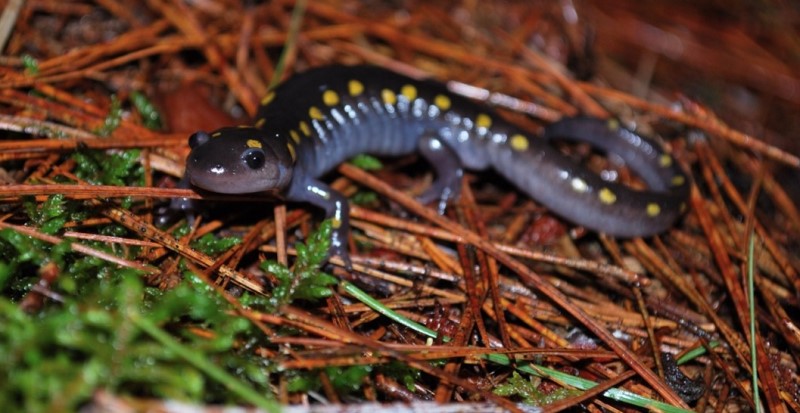Danilo Giacometti and Glenn Tattersall at Brock University explore thermoregulatory strategies of a fossorial salamander in their new research published in Royal Society Open Science.

From the point of view of body temperature control, salamanders are classified as ectotherms. In short, this means that salamanders obtain body heat mainly from the environment, and rely on different behaviours to control the rate of heat exchange between them and their surroundings. Since salamanders are mostly nocturnal, many have suggested their thermoregulatory abilities to be limited compared to diurnal ectotherms, which can efficiently gain heat from basking in the sunlight. On top of being nocturnal, some salamanders are also fossorial. That is, they spend most of their time living in underground burrows, and move to the surface only briefly to forage or to breed. Given that underground temperatures tend to be less variable than aboveground temperatures, studies have recurrently argued that the thermal biology of fossorial ectotherms should be under low selective pressure.
Evidence suggests that fossorial ectotherms typically show low thermoregulatory precision and low evidence of thermotactic (i.e., temperature-seeking) behaviours. Most of these studies, however, used lizards or snakes as model systems, showcasing a taxonomic gap in terms of amphibian thermoregulation. The reasons for this gap are varied, ranging from the fact that fossorial species are often hard to study due to their cryptic lifestyle, to the untested assumption that amphibians prioritise hydroregulation over thermoregulation. Additionally, while underground temperatures are indeed more constant than aboveground temperatures in the short term (e.g., hours or days), fossorial amphibians from the temperate zone experience ample shifts in underground temperatures over longer time scales (e.g., between seasons). To bridge some of these gaps, we used an integrative approach to evaluate how seasonality affected behavioural thermoregulation in a fossorial amphibian, the Spotted Salamander.
We sourced Spotted Salamanders from Bat Lake, Algonquin Provincial Park, ON, Canada and brought them to Brock University. In the lab, we used an acclimatisation regime that mimicked conditions experienced by animals in nature. We then used a laboratory thermal gradient to compare thermoregulatory behaviours between the active (summer) and overwintering (winter) seasons.

Example thermal image of the ring-shaped thermal gradient used in this study: darker colours indicate lower temperatures and lighter colours indicate higher temperatures.
Contrary to previous work in fossorial lizards and snakes, we found that Spotted Salamanders engaged in active behavioural thermoregulation in both the active and overwintering seasons despite being fossorial. Indeed, salamanders showed heat-seeking behaviour in both seasons, as evidenced by the finding that animals selected gradient temperatures that were higher than the prevailing acclimatisation condition. These behavioural differences between seasons translated into a 9.4°C shift in the fundamental thermal niche of Spotted Salamanders, a finding that adds to mounting evidence in support of seasonal plasticity in thermal traits, and against the notion of a “final thermal preferendum” as a paradigm in ectotherm thermal biology.
Besides challenging the notion that fossorial ectotherms should show little motivation to thermoregulate, our study ultimately draws attention to the importance of combining behavioural and thermal biology measurements as a means to understand the mechanisms that underpin body temperature control in ectotherms.
About the authors
Danilo Giacometti is a PhD candidate at Brock University, where he studies the behavioural and physiological correlates of fossoriality in amphibians. He received his MSc from Universidade Federal de São Paulo, where he studied the impact of seasonality over the thermal biology of lizards. He is interested in understanding how organisms respond to environmental variation on spatial and temporal scales, focussing on features that are vital to organismal functioning, such as energetics, hydroregulation, and thermoregulation.
Glenn Tattersall is a Professor of Biological Sciences at Brock University, where he studies physiological and evolutionary aspects of thermal biology. He received his PhD from Cambridge University where he studied hibernation in amphibians, and he currently supervises and collaborates on research projects ranging from thermal and metabolic physiology to morphological adaptations to the environment.
Royal Society Open Science is an open access journal that welcomes the submission of all high-quality science. More information about the journal and the submission process can be found on our webpage.
Image 1. A male Spotted Salamander (Ambystoma maculatum) on top of pine needles on the forest floor surrounding Bat Lake, Algonquin Provincial Park, Ontario, Canada. Photo: Danilo Giacometti.
Image 2. Figure 1 from the paper, Seasonal variation of behavioural thermoregulation in a fossorial salamander (Ambystoma maculatum).




